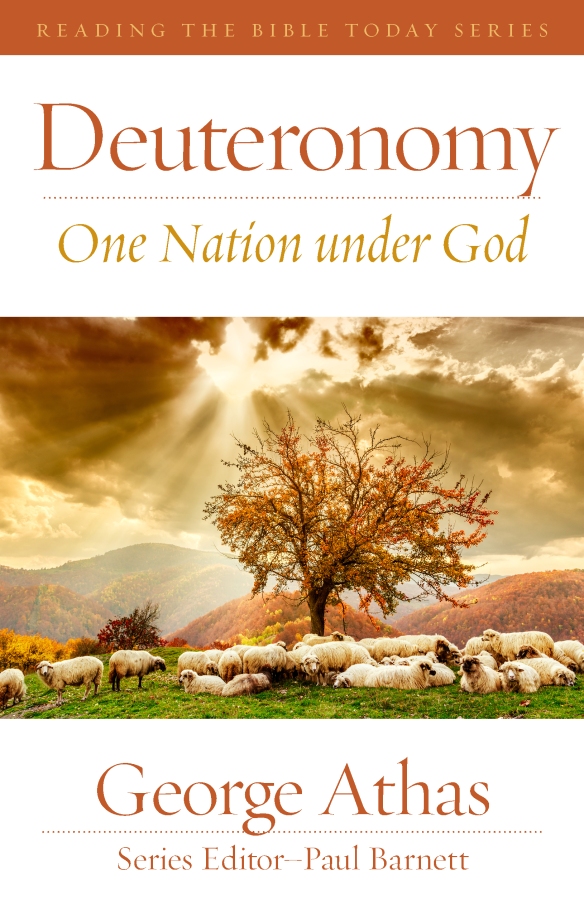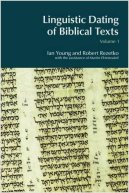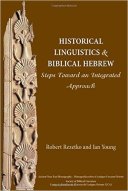 Genesis 3 tells a story of woe in idyllic paradise. After the sneaky snake tempts the woman, both she and the man eat fruit from the tree that Yahweh God had forbidden to them. Consequently, the couple now find themselves with the stark realisation of their nakedness, and dread over what the deity will think of them. And so, when they hear his steps in the garden which they are supposed to tend, they hide in fear and shame.
Genesis 3 tells a story of woe in idyllic paradise. After the sneaky snake tempts the woman, both she and the man eat fruit from the tree that Yahweh God had forbidden to them. Consequently, the couple now find themselves with the stark realisation of their nakedness, and dread over what the deity will think of them. And so, when they hear his steps in the garden which they are supposed to tend, they hide in fear and shame.
After a quick interrogation, Yahweh God determines the guilt of all involved, and issues curses upon them—on the snake, the woman, and the man.
The curse on the man involves a curse on the ground:
“Damn the ground on your account!
With hardship will you eat of it
all the days of your life.
Both thorn and thistle will it sprout for you,
so that you must eat the plants of the field.
By the sweat of your nose will you eat bread,
until your return to the ground.
Since you were taken from it
—for dust is what you are—
then to dust will you return.”— Genesis 3:17b–19 (my translation)
As a result of this curse, the man and the woman are expelled from the paradise garden they were tending, with its variety of fruit-bearing trees. They are sent out into a barren world (cf. Gen 2:5–6), in which the ground is their enemy. Their efforts at toiling no longer yield them the lush fruits of paradise, but the thorns and thistles of frustration. They are forced to work harder than they ever have before, with the sweat of their exertion pouring down their nose. Even then, they will collapse into the hostile ground, or earn the measliest of crusts that will send them foraging for any wild plant in the open field that they can find. And in the end they will die a miserable death.

This sorry situation explains why God found Cain’s offering of the “fruit of the ground” despicable (Gen 4:3–5). Cain could not cultivate anything meriting the status of an offering. He simply brings to the altar whatever he finds sprouting from the ground, rather than what he works to produce. Abel, on the other hand, evidently figures out a way to earn a crust while the curse is in effect: don’t eat the grass, but rather raise and eat the animals that eat the grass. And of these, he offers the firstborn of his flock—the most significant product of his personal work. For this entrepreneurial and respectful effort, he earns Yahweh’s favour.
Yet, the curse on the ground remains, and life for humanity is bitterly harsh. It is a wretched existence that, generations later, leads Noah’s parents to wish (or prophesy) of their son,
“May this one give us relief from our work,
from the hardship of our hands,
from the ground that Yahweh damned.”—Genesis 5:29 (my translation)
I’ve often heard preachers say that we still live with the effects of this curse today. After all, the curse on the ground was just one of several that Yahweh pronounced. Snakes still slither along the ground, as the curse upon the snake stipulated; women give birth in the most horrendous pain, as the woman was cursed in the garden; and the grave is the destiny of us all, as the man’s curse promises. So the earth is also cursed, and the frustration and futility of work are reflective of this.
However, this is not quite right.
To think that the curse on the ground is indicative of our reality today is actually a mistake. For when we read on in Genesis, we find that Yahweh lifts the curse on the ground. After the “uncreation” of the flood, Noah emerges from the ark into a renewed, pristine world, and offers Yahweh a sumptuous sacrifice.
Noah now built an altar to Yahweh, and took some of all the clean animals and some of all the clean birds, and offered them as incinerations on the altar. Yahweh now smelled the appeasing aroma, and Yahweh said in his heart, “I no longer curse the ground on account of the man, even though the intent of the man’s heart be evil from his youth. And I no longer strike down all life as I have just done.”
— Genesis 8:20–21 (my translation)
The lifting of the curse on the ground means that the earth no longer functions as a source of utter frustration for humanity. On the contrary, the earth begins to respond to human cultivation as fruitfully as it did in Eden. Humanity’s agricultural pursuits no longer yield unpalatable brambles. Instead, with human endeavour, the ground can explode in fecundity, allowing humanity to continue the task for which Yahweh originally employed the man in the paradise garden: cultivating the ground. No longer are humans forced to forage for the odd wild plant. The hardship of the past is gone.
Just to underscore the point, with the curse now lifted, Noah decides to become a novice farmer. Evidently, the earth responds to his rookie efforts a little too well:
Noah now began to be a man of the ground. He planted a vineyard, drank some of the wine, and got drunk.
— Genesis 9:20–21a (my translation)
The wish of Noah’s parents, that he give them relief from the hardship of the curse, came true. Accordingly, from Noah onwards, humanity pursues agricultural farming and pastoral farming with great success.
From this, there are three implications I’d like to reflect on.
- The earth is not cursed. It is, rather, a source of wellbeing for humanity, and it is a human responsibility to care for it. The current environmental issues we face on the planet are not because of God, but because of our own irresponsibility.
- Work is not a curse. When Yahweh put the man in the paradise garden of Eden, he commissioned him to work it. There was no sense that the man simply had to snap his fingers to achieve his work goals. There was, rather, the expectation of hard work, but with commensurate reward. As the man cultivated the earth, so it would yield to him, and reward his efforts. The curse that God placed on the man was that the earth would no longer yield to him, making his work futile (“the sweat of your nose” could also be translated as “the sweat of your frustration”). But this situation was temporary, as the Noah narrative indicates. Work is part of God’s good intention for humanity, and decent reward for decent effort should be the way we operate. Indeed, as Abel’s example demonstrates, God is pleased when we work well and honour him.
- We need to stop preaching that the earth is cursed. This includes rethinking the meaning of passages like Romans 8:18–21:
For I think that the sufferings of our present time are not equal to the future glory that is to be revealed to us. For the expectation of creation is awaiting the revelation of the sons of God. For creation was subjected to aimlessness, not willingly, but by the one who subjected it, in the hope that that same creation will be liberated from its servitude to decay into the liberation of the glory of the children of God.
— Romans 8:18–21 (my translation)
This passage is often preached with reference to Genesis 3, and it’s not hard to see why. But if Paul knew his Bible (and he most certainly did—especially the early chapters of Genesis!), he was probably not arguing that the earth continued to be cursed into his own day. Perhaps Paul was specifically looking at the curse on the earth in a typological manner—a precedent, rather than an ongoing reality. Or perhaps Paul saw creation as having an inherent nature of aimlessness—cycles of life and decay, which imbue it with a metaphorical desire to break out of the cycle—to attain an eternal destiny that can only be achieved in God’s greater purposes in Christ. Perhaps there is another explanation. Either way, I don’t think it’s tenable to view Paul as arguing that the curse on the earth was ongoing.
All this is not to suggest that humanity and the world is not “fallen.” Once sin entered the world, it could not be taken back, and we continue to live with the consequences of sin—our own, as well as that of others. Rather, it’s simply to say that we should read the Bible more closely than we do, and base our theology on its entire witness, not just parts of it. As we read Genesis, we see God lift the curse on the ground, and so we should distinguish that curse from the evident tendency to death and decay that we (still) see in the world around us.



 In a hot-off-the-press popular article in Biblical Archaeology Review (September/October 2016), Avi Hurvitz discusses “How Biblical Hebrew Changed.” It is certainly true that Biblical Hebrew evolved over time, but the particulars of how that happened are more complex and debated than Hurvitz acknowledges. The example that he discusses, ʾiggeret and sēfer for “letter,” is a case in point.
In a hot-off-the-press popular article in Biblical Archaeology Review (September/October 2016), Avi Hurvitz discusses “How Biblical Hebrew Changed.” It is certainly true that Biblical Hebrew evolved over time, but the particulars of how that happened are more complex and debated than Hurvitz acknowledges. The example that he discusses, ʾiggeret and sēfer for “letter,” is a case in point.


 Richard Dawkins reflects this kind of scenario when he questions the character and justice of God. He asks, quite perceptively, why it is necessary for the God of the Bible to send his Son to die a bloody death for sin. Why could God simply not forgive sins with a wave of his hand, as it were? Can’t God just simply waive the penalty and move on?
Richard Dawkins reflects this kind of scenario when he questions the character and justice of God. He asks, quite perceptively, why it is necessary for the God of the Bible to send his Son to die a bloody death for sin. Why could God simply not forgive sins with a wave of his hand, as it were? Can’t God just simply waive the penalty and move on? This is why the cure for sin requires the Incarnation. It takes God himself to become a human being—the image of God—and so redefine human nature. Christ is the new Adam—the one who fixes human nature and relates rightly to God. It is Jesus’ entire human life that is redemptive—not just his death and resurrection. He overcomes the devastation of human nature, which every human suffers. And because of humanity’s place as God’s image over all creation, the redemption of human nature entails the redemption of all creation.
This is why the cure for sin requires the Incarnation. It takes God himself to become a human being—the image of God—and so redefine human nature. Christ is the new Adam—the one who fixes human nature and relates rightly to God. It is Jesus’ entire human life that is redemptive—not just his death and resurrection. He overcomes the devastation of human nature, which every human suffers. And because of humanity’s place as God’s image over all creation, the redemption of human nature entails the redemption of all creation.

 Conventional wisdom says that Early Biblical Hebrew (aka Standard Biblical Hebrew or Classical Biblical Hebrew) came first, and then Late Biblical Hebrew. But when you actually analyse the evidence, this view starts to unravel. Ian Young, Robert Rezetko, and Martin Ehrensvärd have argued very convincingly that Early Biblical Hebrew and Late Biblical Hebrew were not linear diachronic developments, but rather contemporaneous styles of Hebrew in antiquity. This means that it’s practically impossible to date a biblical text based solely on linguistic criteria. Their compelling argument can found in their two volume work,
Conventional wisdom says that Early Biblical Hebrew (aka Standard Biblical Hebrew or Classical Biblical Hebrew) came first, and then Late Biblical Hebrew. But when you actually analyse the evidence, this view starts to unravel. Ian Young, Robert Rezetko, and Martin Ehrensvärd have argued very convincingly that Early Biblical Hebrew and Late Biblical Hebrew were not linear diachronic developments, but rather contemporaneous styles of Hebrew in antiquity. This means that it’s practically impossible to date a biblical text based solely on linguistic criteria. Their compelling argument can found in their two volume work,  In the book of Judges, we encounter the mighty Israelite judge, Samson. He is perhaps best known for his herculean strength. Yet, he is also known for his weakness for women—especially Philistine women. His relationship with Delilah, often portrayed as a sneaky seductress, was his undoing. She coaxed him into divulging the secret of his strength: his long braids of hair. Though they were the symbol of his devotion to God, they were also his “Achilles’ heel.”
In the book of Judges, we encounter the mighty Israelite judge, Samson. He is perhaps best known for his herculean strength. Yet, he is also known for his weakness for women—especially Philistine women. His relationship with Delilah, often portrayed as a sneaky seductress, was his undoing. She coaxed him into divulging the secret of his strength: his long braids of hair. Though they were the symbol of his devotion to God, they were also his “Achilles’ heel.”

 Some modern depictions of Delilah portray her as the opportunist seductress, who uses her wiles and lack of scruples to make a quick buck. Some view her as a prostitute making a bit of extra cash while tricking her trick. Of course the Philistine leaders would pay for her services! Why, perhaps she even once serviced them? But Delilah was not the prostitute whom Samson visited in Gaza along the coast. Delilah didn’t live in Gaza! She lived up in the hills in the Valley of Sorek. And the biblical text never so much as implies that she was a prostitute. It seems that, as with Mary Magdalene, Delilah has been mistakenly thought of as a hustler when she wasn’t!
Some modern depictions of Delilah portray her as the opportunist seductress, who uses her wiles and lack of scruples to make a quick buck. Some view her as a prostitute making a bit of extra cash while tricking her trick. Of course the Philistine leaders would pay for her services! Why, perhaps she even once serviced them? But Delilah was not the prostitute whom Samson visited in Gaza along the coast. Delilah didn’t live in Gaza! She lived up in the hills in the Valley of Sorek. And the biblical text never so much as implies that she was a prostitute. It seems that, as with Mary Magdalene, Delilah has been mistakenly thought of as a hustler when she wasn’t! In any case, it seems we have been treating Delilah as a Philistine, when she is actually an Israelite. She is not a conniving professional seductress, but a local girl who betrays a leader (albeit a very flawed one) of her own people. She was more traitor than temptress. In that way, she is perhaps the antithesis of Jael, wife of Heber, who causes the downfall of Sisera in Judges 4. This would be in keeping with the upending of Israel’s fortunes throughout the book of Judges and the portrayal of Israel’s descent into chaos. Delilah is still a sinister figure, but for perhaps slightly different reasons to what we previously thought.
In any case, it seems we have been treating Delilah as a Philistine, when she is actually an Israelite. She is not a conniving professional seductress, but a local girl who betrays a leader (albeit a very flawed one) of her own people. She was more traitor than temptress. In that way, she is perhaps the antithesis of Jael, wife of Heber, who causes the downfall of Sisera in Judges 4. This would be in keeping with the upending of Israel’s fortunes throughout the book of Judges and the portrayal of Israel’s descent into chaos. Delilah is still a sinister figure, but for perhaps slightly different reasons to what we previously thought.